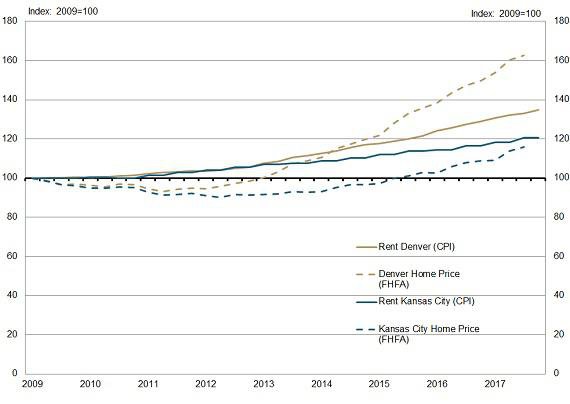Using the latest results from the Low- and Moderate-Income (LMI) Survey and other sources of economic data, the March 9 issue of Tenth District LMI Economic Conditions highlights economic conditions in LMI communities. The consensus of survey respondents is that LMI communities are lagging the rest of the economy for many reasons, including compensation and housing.
Variations in Employment and Wages
General labor metrics remain robust. Unemployment in the United States was 4.1 percent in the fourth quarter of 2017, while unemployment in LMI households was 6.5 percent. The U-6 unemployment rate, which consists of the unemployed, reluctant part-time workers and people discouraged from seeking work, was 8.1 percent nationally and 11.5 percent in LMI communities, an improvement from June.
LMI Survey respondents’ consensus on labor conditions overall was positive. However, survey contacts reported LMI communities face stagnant wages and little growth in compensation. The Bureau of Labor Statistics reports average compensation growth from the fourth quarter of 2012 to the fourth quarter of 2017 was 0.3 percent—low by historical standards—and that compensation growth in the five years following the Great Recession was near zero.
Rising Housing Costs
Many survey respondents indicated that the most significant problem facing LMI communities is affordable housing and that housing costs for both renters and homeowners have strained household budgets. The chart below compares rents (a component of the Consumer Price Index) and the home price index for Kansas City and Denver. Since 2009, rents have increased 58 percent in Denver and 32 percent in Kansas City. Trends for home prices have been similar. Since 2009, home prices have increased 68 percent in Denver and 20 percent in Kansas City. Omaha and Oklahoma experienced similar increases of 21 percent and 22 percent, respectively. In addition to rising costs for market-rate housing, survey respondents noted an insufficient stock of affordable housing and long waiting lists for subsidized housing.
Chart 6. Rent Costs and Home Prices in Denver and Kansas City

Success in Workforce Development
This issue of Tenth District LMI Economic Conditions also examined characteristics shared by successful workforce programs. Respondents indicated that successful programs tended to be tailored for specific populations, employer-informed and well-structured. For example, apprenticeships commonly were listed as successful programs for skills training, specifically in sectors such as IT and warehouse work. Mentorships, on the other hand, had more psychosocial benefits.
Additional Insights
The report also discusses other issues affecting the LMI community such as reasons why people decide not to work, additional labor metrics and trends in consumer confidence for LMI households. The full report is available here.
About the LMI Survey
The LMI Survey was launched in 2009 as an effort to better understand economic conditions in LMI Communities. Responses from the survey inform community development strategies, guide research and assist with monetary policy decisions. The survey is distributed biannually to more than 2,500 community leaders serving LMI populations. The next survey will be distributed in July. Those who work directly with LMI populations are encouraged to participate by signing up to join the survey.
